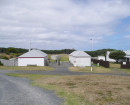Back to search results
LAURENCE PARK HOMESTEAD
56 BUCHTER ROAD BATESFORD, GOLDEN PLAINS SHIRE
LAURENCE PARK HOMESTEAD
56 BUCHTER ROAD BATESFORD, GOLDEN PLAINS SHIRE
All information on this page is maintained by Heritage Victoria.
Click below for their website and contact details.
Victorian Heritage Register
-
Add to tour
You must log in to do that.
-
Share
-
Shortlist place
You must log in to do that.
- Download report

laurence park homestead buchter road batesford front window detail publication


On this page:
Statement of Significance
Work on the Laurence Park homestead commenced in 1845 for Dr John Learmonth (1812-1871), the son of the pastoralist Thomas Learmonth (1783 - 1869), following the destruction by fire of an earlier 1842-43 homestead. The site in Crown Portion 25, Parish of Gheringhap, was part of several large parcels of land owned by the Port Philip Assocation, purchased for the famous Clyde Company. This company was formed in Tasmania with Scottish backing and
occupied the Moorabool Valley above Batesford early in 1836.
John Ritchie built Laurence Park on land purchased from the Port Philip Association by Thomas Learmonth and conveyed to his son in 1845. The homestead was named after Thomas Learmonth's former holding near Falkirk. Laurence Park was sold by John Ritchie in February 1867 to George Hope for 6186 pounds. Five months later he sold it to George Hill for 5913 pounds. The Hill family arrived in Batesford in 1854. The Hills, who have owned the property from the late 1860s until the present time, are responsible for all the post - 1860s alterations and additions.
Laurence Park is an h-shaped colonial vernacular building with gabled roofs. The earliest part is brick, that is, the north wing and middle section of the H. The south wing constructed in the 1860s is of random rubble. There are verandahs on the north and east sides. The house has been altered over the years and little remains internally of the original features. The only section in original condition is the uppper level of the stone wing. A steep, narrow timber stair leads up to it. The overall condition of the building could be described as good, although the soft early bricks are deteriorating at floor level.
Laurence Park homestead has both architectural and historical significance:
1. It is one of the earliest surviving buildings in the Geelong region, work on it having commenced in 1845 for Dr John Learmonth following the destruction by fire of an earlier 1842-43 Homestead.
2. This homestead illustrates the pragmatic development of rural vernacular dwellings using local materials.
3. It has significant association with the early history of the Geelong area as an important pastoral region when its site, along with other large tracts of land, was owned by the famous Clyde Company and then the Port Philip Association.
4. From the 1840s the property was significant associations with the early pastoral enterprise of the celebrated Learmonth family and particularly with Dr John Learmonth (1812-1871), the son of Thomas Lerrmonth (1783 - 1869).
5. Laurence Park has been in the ownership of another Scottish family, the Hills, from the late 1860s until the present time, the Hills being responsible for all the post1860s additions.
occupied the Moorabool Valley above Batesford early in 1836.
John Ritchie built Laurence Park on land purchased from the Port Philip Association by Thomas Learmonth and conveyed to his son in 1845. The homestead was named after Thomas Learmonth's former holding near Falkirk. Laurence Park was sold by John Ritchie in February 1867 to George Hope for 6186 pounds. Five months later he sold it to George Hill for 5913 pounds. The Hill family arrived in Batesford in 1854. The Hills, who have owned the property from the late 1860s until the present time, are responsible for all the post - 1860s alterations and additions.
Laurence Park is an h-shaped colonial vernacular building with gabled roofs. The earliest part is brick, that is, the north wing and middle section of the H. The south wing constructed in the 1860s is of random rubble. There are verandahs on the north and east sides. The house has been altered over the years and little remains internally of the original features. The only section in original condition is the uppper level of the stone wing. A steep, narrow timber stair leads up to it. The overall condition of the building could be described as good, although the soft early bricks are deteriorating at floor level.
Laurence Park homestead has both architectural and historical significance:
1. It is one of the earliest surviving buildings in the Geelong region, work on it having commenced in 1845 for Dr John Learmonth following the destruction by fire of an earlier 1842-43 Homestead.
2. This homestead illustrates the pragmatic development of rural vernacular dwellings using local materials.
3. It has significant association with the early history of the Geelong area as an important pastoral region when its site, along with other large tracts of land, was owned by the famous Clyde Company and then the Port Philip Association.
4. From the 1840s the property was significant associations with the early pastoral enterprise of the celebrated Learmonth family and particularly with Dr John Learmonth (1812-1871), the son of Thomas Lerrmonth (1783 - 1869).
5. Laurence Park has been in the ownership of another Scottish family, the Hills, from the late 1860s until the present time, the Hills being responsible for all the post1860s additions.
Show more
Show less
-
-
LAURENCE PARK HOMESTEAD - History
Associated People:
LAURENCE PARK HOMESTEAD - Permit Exemptions
General Exemptions:General exemptions apply to all places and objects included in the Victorian Heritage Register (VHR). General exemptions have been designed to allow everyday activities, maintenance and changes to your property, which don’t harm its cultural heritage significance, to proceed without the need to obtain approvals under the Heritage Act 2017.Places of worship: In some circumstances, you can alter a place of worship to accommodate religious practices without a permit, but you must notify the Executive Director of Heritage Victoria before you start the works or activities at least 20 business days before the works or activities are to commence.Subdivision/consolidation: Permit exemptions exist for some subdivisions and consolidations. If the subdivision or consolidation is in accordance with a planning permit granted under Part 4 of the Planning and Environment Act 1987 and the application for the planning permit was referred to the Executive Director of Heritage Victoria as a determining referral authority, a permit is not required.Specific exemptions may also apply to your registered place or object. If applicable, these are listed below. Specific exemptions are tailored to the conservation and management needs of an individual registered place or object and set out works and activities that are exempt from the requirements of a permit. Specific exemptions prevail if they conflict with general exemptions. Find out more about heritage permit exemptions here.
-
-
-
-
-
LAURENCE PARK HOMESTEAD
 Victorian Heritage Register H0887
Victorian Heritage Register H0887
-
"1890"
 Yarra City
Yarra City -
"AMF Officers" Shed
 Moorabool Shire
Moorabool Shire -
"AQUA PROFONDA" SIGN, FITZROY POOL
 Victorian Heritage Register H1687
Victorian Heritage Register H1687
-
Archaeological site
 Southern Grampians Shire
Southern Grampians Shire -
Avoca
 Stonnington City H0809
Stonnington City H0809 -
BANYULE
 Victorian Heritage Register H0926
Victorian Heritage Register H0926
-
-












